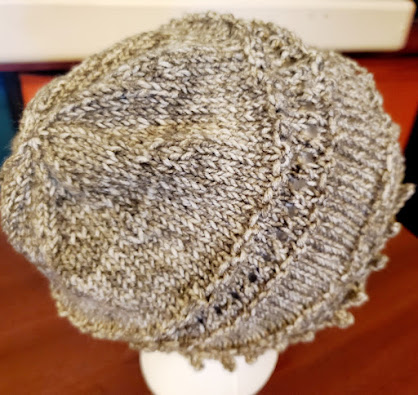I searched the internet for a guide on creating my own knitting patterns and stumbled upon an excellent blog post on the subject at SisterMountain.
Here is what I read on the SisterMountain blog.
Choosing a Pattern Category When starting to design your
first knitting pattern, consider the type of item you want to create. Are you
interested in making a hat, shawl, or something entirely different? I highly
recommend selecting a category you have experience knitting from other
designers' patterns to build confidence in your design's structure. If you're
skilled in sock knitting, start with your first sock pattern!
Additionally, opt for a pattern category that doesn't
require extensive grading, if any. A simple accessory pattern is ideal.
Crafting something without grading allows you to focus on mastering the
knitting pattern design process, which is invaluable for novice pattern
designers.
If you do decide to explore grading, choose a pattern
category that requires grading for only a limited range of sizes, like a hat.
This provides an opportunity to practice on a smaller scale before tackling
multi-sized garments.
Defining Your Vision Having a clear vision for your design
is essential for new knitting pattern designers to avoid distraction, loss of
confidence, or giving up on your initial project. Creating a mood board is an
effective way to clarify your design concept. Gather images that inspire the
silhouette, stitches, color palette, yarn choice, and overall aesthetic. Adding
keywords to the mood board enhances specificity.
With a mood board in hand, start sketching your ideas on
paper. Don't worry about artistic skill; your sketches are meant to translate
abstract concepts into tangible forms. As long as they convey your intended
message, they are sufficient. Resist the urge to overcomplicate your initial
design; simplicity enables successful completion and boosts confidence for
future, more ambitious projects.
Utilize a Stitch Dictionary I strongly recommend using
stitch patterns from a stitch dictionary for your designs. Given the various
aspects to learn in knitting pattern design, postponing charting and creating
your stitch pattern until later stages can be advantageous. If simplicity is
your goal for your first design, consider using basic stitches like stockinette
or garter stitch. This simplifies the learning curve for the technical aspects
of design.
Choosing the Right Yarn Once you've finalized your design
and identified the featured stitch or motif, it's time to choose your yarn.
Your choice should align with the design's requirements. Consider the design's
needs and select yarn that complements these aspects. For example, a lace shawl
requires yarn with drape and stitch definition to highlight the lace's beauty.
Conversely, a simple hat offers an opportunity to showcase captivating yarn,
such as hand-dyed or variegated options. Ensure it has sufficient memory and
elasticity to maintain the hat's shape.
Thorough Swatching Thorough swatching is crucial to ensure
your design matches your vision, especially if you're a novice knitting pattern
designer. A generous gauge swatch improves gauge accuracy, helping your design
achieve the desired measurements. Swatching also aids in problem-solving and
refining your ideas, instilling confidence in your design and pattern
construction. The more swatches you create, the better you understand your
design, leading to improved results.
Creating a Construction Summary Designing your first
knitting pattern may present challenges in estimating necessary stitch/row
counts and shaping. Compose a simple, step-by-step summary outlining your
construction process. This assists in identifying the numbers to include in
your pattern spreadsheet. While others may not read this summary, it simplifies
writing your knitting pattern, especially for beginners.
Developing a Basic Pattern Spreadsheet Even for
straightforward patterns, pattern spreadsheets are invaluable, especially for
complex or graded designs. I encourage early adoption of pattern spreadsheets,
as they build confidence and proficiency. Include intended finished
measurements and gauge, and refer to your construction summary for systematic
pattern number calculations. For instance, to calculate cast-on stitches for a
bottom-up hat, base it on the main fabric's gauge to ensure a comfortable fit.
Drafting the Initial Pattern At this point, you have the
necessary information to draft your pattern. Embrace imperfections in your
first draft. Study patterns you enjoy to understand the structure and essential
information. Adopt a pattern writing style that feels natural. Don't obsess
over perfection; focus on progress. Writing and knitting simultaneously may
hinder "test-knitting" your pattern, so use this approach sparingly.
Knitting the Sample Before starting the sample, weigh your
yarn, especially if using different colorways or yarns in a single design. This
information helps determine yarn requirements later. If you've written your
pattern before knitting the sample, you effectively become the first test
knitter. This allows you to identify errors or confusion as you knit and update
the pattern accordingly. After knitting, reweigh the yarn to calculate usage,
refining the pattern instructions further.
Engage Test Knitters Test knitting provides an opportunity
to see your pattern from other knitters' perspectives. Its main purpose is to
gather feedback on usability, ensuring a user-friendly design. You'll also gain
insight into the knitting experience and fit of the project, which is
invaluable.
Capturing Simple, Attractive Photos Creating pattern photos
can be intimidating for new designers. You don't need advanced photography
skills or equipment. A willing model, smartphone, natural light, and a
clutter-free background are sufficient. Take photos from the front, back, and
side, highlighting key details. Including model photos helps knitters visualize
the garment on the body, enhancing the pattern's appeal.
You will find more information on the subject at Sister Mountain.com blog























